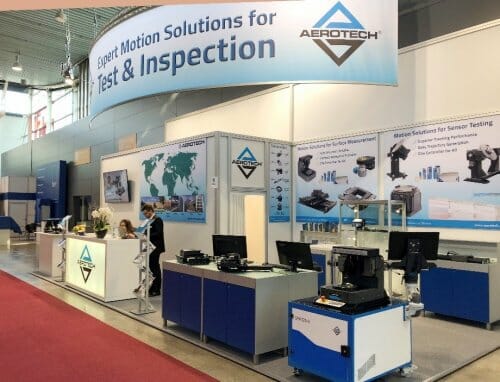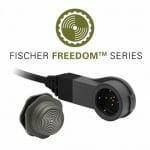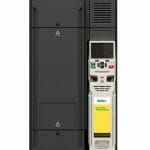Well positioned – Aerotech presents new IGM linear motion platform at Micronora
Aerotech presents innovative linear and rotary tables for demanding laser machining processes at this year’s Micronora precision and microtechnology fair in Besançon France (September 25-28). For the first time, the IGM linear motion platform, developed to meet the highest precision requirements, will be presented to a broad specialist audience: According to the manufacturer, unique, customer-specific assembly of the components directly on granite enables higher stiffness, longer travels and more cost-effective production.
At the end of September, “Micronora” takes place for the 20th time in Besançon, France. Trade visitors from all over the world look forward to cross-sector innovations in the fields of microtechnology and nanotechnology. For sure, the experts from Aerotech should not be missed: The Pittsburgh-based manufacturer develops high-precision motion control systems, positioning tables and associated software solutions. These are used whenever high throughput is required, i.e. in industry, science and research.
Trade fair premiere for the new Aerotech IGM linear motion platform
“At Micronora, we will be presenting our new IGM linear motion platform for the first time. Compared to conventional motion platforms, these offer higher stiffness, reduced height and consequently increased design flexibility”, emphasizes Simon Smith, Director Europe at Aerotech. Depending on requirements, travel load, payload capacity and dynamic performance can be adapted to specific applications. In the so-called IGM system (Integrated Granite Motion Systems), machine components such as bearings, encoders and drives are attached directly to the granite structure and the bridge constructions. This distinguishes IGM systems from conventional positioning stage-on-granite systems, where discreet positioning stages and machine components are used in the system design. “Our IGM systems are custom-engineered to fit the special requirements of respective applications or production processes,” assures Simon Smith, Director Europe.
Manufactured to customer and application specifications
At Micronora, Aerotech will then present trade visitors with various versions incorporating mechanical or air-bearing axles. Ball screw or linear motors can be chosen as drives. In addition, various feedback options are available, ranging from simple encoders to laser interferometers. Finally, additional axes of motion such as rotary, lift, piezo stages or even galvanometers can be integrated into the IGM axes all of which can be controlled centrally via the Aerotech A3200 machine control platform. Other Aerotech solutions on display at Micronora include Planar DL, a directly driven biaxial mechanical linear motion system; ANT95R, a directly driven single axis rotary nanopositioning platform and; ANT130L, another directly driven linear platform with mechanical bearings.
Planar DL series platforms offer excellent geometric and dynamic performance in a compact low-profile package. With many different travel and performance options, this system is ideal for a range of applications from surface profiling to LED wafer scribing.
The directly driven ANT95-R rotary motion platforms are part of Aerotech’s “Nano Motion Technology” series. The rotary motion platform offers unparalleled position stability (0.005 angular seconds) and an incremental movement of less than 0.01 angular seconds. They are available in two accuracy levels.
The ANT130L series offers performance in the nanometer range with travels up to 160mm. With its low profile and outstanding features, the ANT130L is the ultimate solution for high precision alignment, inspection, positioning and measurement stations.
Simplified optimization of travel and payload
Both the IGM systems and the conventional positioning motion systems with granite base have a well-engineered and convincing design. The choice of which system is the right one depends strongly on the respective application or process, prevailing technical and other requirements. IGM systems generally have a higher stiffness because fewer parts have to be integrated resulting in higher positioning accuracy and better dynamic performance. In addition, IGM systems are often more compact due to better integration of machine components into the granite structure.
Manufacturer with many years of know-how
Aerotech has already gained extensive experience in the development, design and manufacture of customer-specific IGM systems. “We are aware that each user has very specific requirements for the design of its systems. That’s why we always work in close consultation with our customers to determine which requirements apply in each case and which type of solution best meets these requirements – with an IGM system or with a traditional stage-on-granite system”, explains Simon Smith the procedure and, emphasizes in view of the upcoming trade fair: “We look forward to an exciting trade fair, many interesting contacts and every trade visitor whom we are allowed to convince of our high innovative strength!
(info box, 4 questions to Simon Smith)
With IGM (Integrated Granite Motion Systems) Aerotech presents a completely new product innovation at Micronora: Four central questions for Simon Smith, Director Europe.
Simon Smith, with IGM you have developed a new design for components in machines, what exactly is behind it?
Simon Smith (SS): The idea behind IGM, i.e. Integrated Granite + Motion, is as simple as it is effective. We no longer exactly place a complete linear adjuster on granite, but rather its individual components, so that the guide, drive and measuring system are mounted directly in the granite and not via detour of a complete adjuster. As a result for the first time, motion components are marketed as a product group and no longer as a purely special solution for the customer as was previously the case.
How does the IGM motion platform differ from other multi-axis motion systems?
SS: In the classic design, linear adjusters are screwed onto a granite base, i.e. onto a flat base as counterweight, in order to be able to safely accelerate and move such large masses. IGM motion platforms were already available for special production purposes, but due to our flexible component concept we can apply these individual production characteristics variably to a series, i.e. we use the components to assemble an application-specific positioning motion system according to customer requirements. Nevertheless: IGM should not be understood as a finished product, but as a concept to show how customer-specific motion systems can be built flexibly. For example, we can show how the axes and guide rails can be arranged in order to then design the system to customer specifications.
You mentioned flexibility at the beginning, what do you exactly mean?
SS: IGM is more flexible and scalable than conventional positioning solutions, as individual components can be selected thus they are optimally matched to dimensions and masses of the objects to be moved. Dimensions and profile widths have been defined for previous adjusters. Let us take the guide rails as an example. We can select the distance and profile of the rails so that the moving object is guided almost perfectly. Of course, the same applies to the length, i.e. the positioning range.
And what are the main advantages?
SS: The advantages are obvious: On one hand, we need less installation space for the component design of the linear motion platform, since the overall height is noticeably reduced, on the other hand, the accuracy increases. With each mechanical interface – adjuster, guide, linear slide, screw connection, etc. – certain tolerances result; if we omit one component, the stiffness and thus the accuracy increases ad hoc. By eliminating intermediate plates, the Abbe offset is smaller, so that we achieve a higher machine positioning accuracy especially when there is higher acceleration.





